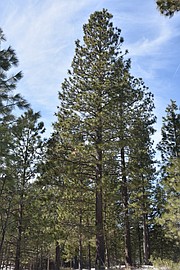Pondering the ponderosa pine
“The ponderosa is one of the most widely distributed trees in the interior West, extending from southern British Columbia southward in two main branches: down the Cascades and Sierras into Southern California, and through the Rockies into Arizona and New Mexico. It is at home at high elevations.”
Scottish botanist-explorer David Douglas named the tree (in Latin) “pinus ponderosea” in 1826. He chose the word “ponderosa,” meaning ponderous or heavy, because of its sheer bulk. The Latin name eventually became the common name.
One of the first conifers I learned to identify after moving to Boundary County was the majestic ponderosa pine, mainly because of the bark and needle cluster. I had never seen a tree with such unique bark.
I later learned that only the older ponderosa pine had the characteristic orange-colored bark, while the younger trees being less than 100 to 120 years of age had dark brown to black bark. Another difference between young and old ponderosa lies within the tree. Young ponderosa, called bull pine, have coarse, knotty wood while old ponderosa called western yellow pine have clear, even-grained wood.
Ponderosa pines are also called yellow pine, rock pine, yellow bellies and blackjack pine. No matter what ponderosa are called, there is no other type of forest like a ponderosa pine forest. The openness of a ponderosa pine stand creates a park-like setting, except the ground is littered with long ponderosa pine needles and pine cones instead of grass. Ponderosa pines have long (5-8 inch) needles in bundles of three and egg-shaped cones.
I like to explore open ponderosa pine ridges because of their vastness and ability to see farther, especially while looking for shed antlers. These open-stands are often found on dry, south-facing slopes or ridges because they are able to grow in drier soils.
To recognize a ponderosa pine, find a conifer with long needles, then count the number of needles in a bundle. If there are five, it’s a white pine. If there are two, it’s a lodgepole pine. If there are three, it’s a ponderosa pine.
The seeds of the ponderosa pine, which are released from the cone and descend on inch-long wings, were also used as food by the early American natives. Squirrels and birds are also partial to them. Beware of the cone. Pick one up. Ouch, they hurt your fingers. Ponderosa cones have a nasty sharp prickle at the tip of each scale.
Boundary County residents are well aware of one ponderosa disadvantage: It sheds large piles of needles and cones every fall. All in all, however, the ponderosa is not a particularly high maintenance yard tree compared to many deciduous trees.
Ponderosa pine need an extensive root system to supply moisture to the long tufts of needles and to support the massive trunks that old trees can produce. When a ponderosa pine attains an age of 400 to 500 years of age, it can be upward of four to five feet in diameter and more than 120 feet high. The largest ponderosa pine in Idaho is six feet in diameter and 182 feet tall while the largest ponderosa in the country is seven-and-a-half feet in diameter and 240 feet tall.
Ponderosa trees this big were considered ‘old’ when Lewis and Clark first described them on their expedition in 1804.
Enjoy Boundary County and all its beauty!



